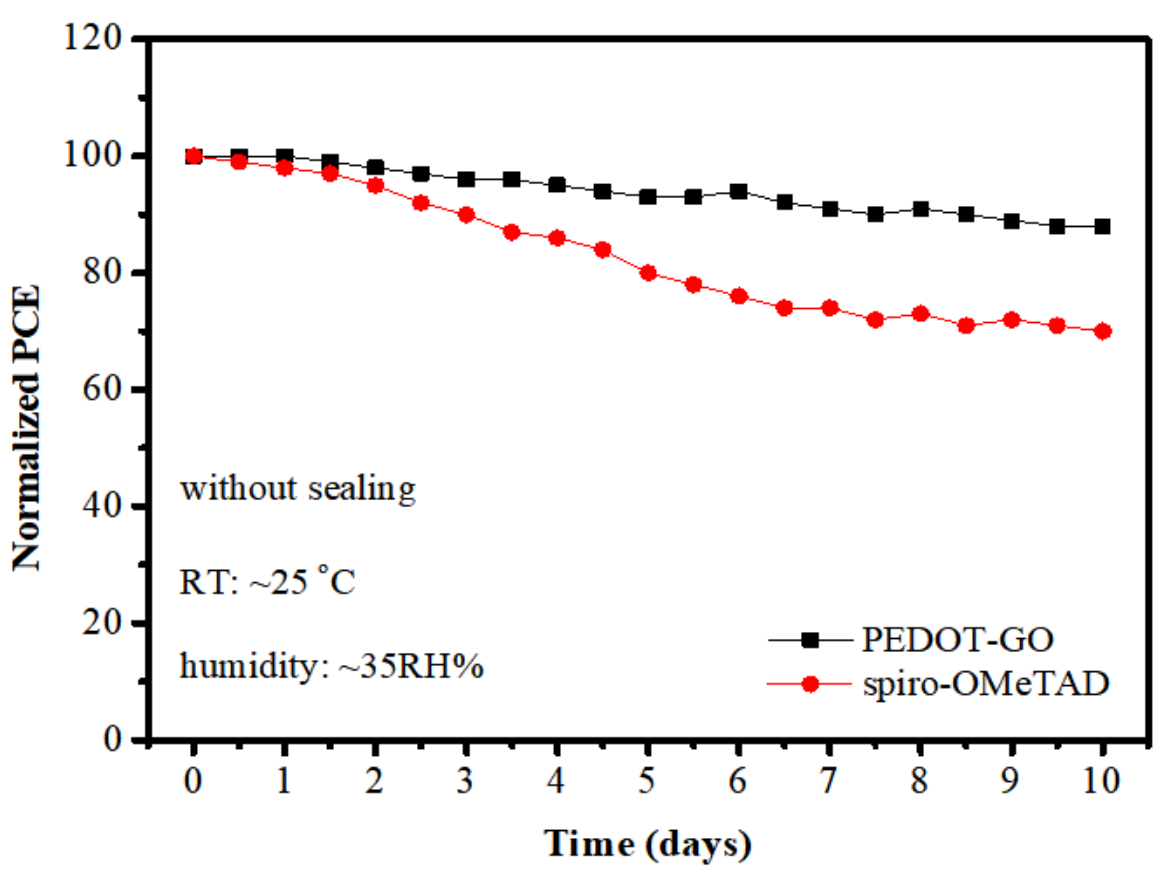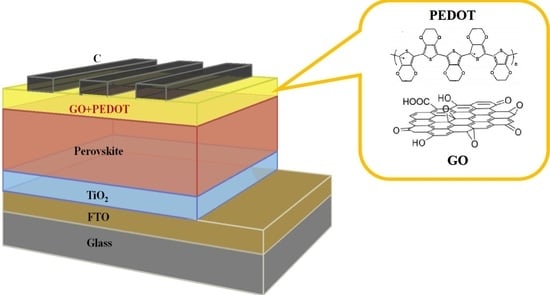Composited Film of Poly(3,4-ethylenedioxythiophene) and Graphene Oxide as Hole Transport Layer in Perovskite Solar Cells
Abstract
:1. Introduction
2. Materials and Methods
2.1. Material Preparation
2.2. Fabrication of Device
2.3. Device Characterization
3. Results and Discussion
4. Conclusions
Author Contributions
Funding
Institutional Review Board Statement
Informed Consent Statement
Data Availability Statement
Acknowledgments
Conflicts of Interest
References
- Song, Z.N.; McElvany, C.L.; Phillips, A.B.; Celik, I.; Krantz, P.W.; Watthage, S.C.; Liyanage, G.K.; Apul, D.; Heben, M.J. A technoeconomic analysis of perovskite solar module manufacturing with low-cost materials and techniques. Energy Environ. Sci. 2017, 10, 1297–1305. [Google Scholar] [CrossRef]
- Chen, X.; Xu, G.; Zeng, G.; Gu, H.W.; Chen, H.Y.; Xu, H.T.; Yao, H.F.; Li, Y.W.; Hou, J.H.; Li, Y.F. Realizing Ultrahigh Mechanical Flexibility and >15% Efficiency of Flexible Organic Solar Cells via a Welding Flexible Transparent Electrode. Adv. Mater. 2020, 32, 1908478. [Google Scholar] [CrossRef] [PubMed]
- Correa-Baena, J.P.; Tress, W.; Domanski, K.; Anaraki, E.H.; Turren-Cruz, S.H.; Roose, B.; Boix, P.P.; Grätzel, M.; Saliba, M.; Abate, A.; et al. Identifying and suppressing interfacial recombination to achieve high open-circuit voltage in perovskite solar cells. Energy Environ. Sci. 2017, 10, 1207–1212. [Google Scholar] [CrossRef]
- Jung, E.H.; Jeon, N.J.; Park, E.Y.; Moon, C.S.; Shin, T.J.; Yang, T.Y.; Noh, J.H.; Seo, J.W. Efficient, stable and scalable perovskite solar cells using poly(3-hexylthiophene). Nature 2019, 567, 511–515. [Google Scholar] [CrossRef] [PubMed]
- Arora, N.; Dar, M.I.; Hinderhofer, A.; Pellet, N.; Schreiber, F.; Zakeeruddin, S.M.; Graetzel, M. Perovskite solar cells with cuscn hole extraction layers yield stabilized efficiencies greater than 20%. Science 2017, 358, 768–771. [Google Scholar] [CrossRef] [Green Version]
- Zhao, Q.; Wu, R.; Zhang, Z.; Xiong, J.; He, Z.; Fan, B.; Dai, Z.; Yang, B.; Xue, X.; Cai, P.; et al. Achieving efficient inverted planar perovskite solar cells with nondoped ptaa as a hole transport layer. Org. Electron. 2019, 71, 106–112. [Google Scholar] [CrossRef]
- Han, W.; Ren, G.; Liu, J.; Li, Z.; Guo, W.; Bao, H.; Liu, C.; Guo, W. Recent progress of inverted perovskite solar cells with a modified PEDOT:PSS hole transport layer. ACS Appl. Mater. Interfaces 2020, 12, 49297–49322. [Google Scholar] [CrossRef]
- Lian, X.; Chen, J.; Zhang, Y.; Tian, S.; Qin, M.; Li, J.; Andersen, T.R.; Wu, G.; Lu, X.; Chen, H. Two-dimensional inverted planar perovskite solar cells with efficiency over 15% via solvent and interface engineering. J. Mater. Chem. A 2019, 7, 18980–18986. [Google Scholar] [CrossRef]
- Lin, Y.J.; Ni, W.S.; Lee, J.Y. Effect of incorporation of ethylene glycol into PEDOT:PSS on electron phonon coupling and conductivity. J. Appl. Phys. 2015, 117, 215501–215504. [Google Scholar] [CrossRef]
- Jiang, X.; Yu, Z.; Zhang, Y.; Lai, J.B.; Li, J.J.; Gurzadyan, G.G.; Yang, X.C.; Sun, L.C. High-Performance Regular Perovskite Solar Cells Employing Low-Cost Poly(ethylenedioxythiophene) as a Hole-Transporting Material. Sci. Rep. 2017, 7, 42564. [Google Scholar] [CrossRef]
- Yu, W.; Wang, K.; Guo, B.; Qiu, X.; Hao, Y.; Chang, J.J.; Li, Y. Effect of ultraviolet absorptivity and waterproofness of poly(3,4-ethylenedioxythiophene) with extremely weak acidity, high conductivity on enhanced stability of perovskite solar cells. J. Power Sources 2017, 358, 29–38. [Google Scholar] [CrossRef]
- Wu, Z.; Bai, S.; Xiang, J.; Yuan, Z.; Yang, Y.; Cui, W.; Gao, X.Y.; Liu, Z.; Jin, Y.Z.; Sun, B.Q. Efficient planar heterojunction perovskite solar cells employing graphene oxide as hole conductor. Nanoscale 2014, 6, 10505–10510. [Google Scholar] [CrossRef]
- Wang, M.; Duan, X.; Xu, Y.; Duan, X. Functional three-dimensional graphene/polymer composites. ACS Nano 2016, 10, 7231–7247. [Google Scholar] [CrossRef]
- Oger, N.; Lin, Y.T.F.; Labrugere, C.; le Grognec, E.; Rataboul, F.; Felpin, F.X. Practical and scalable synthesis of sulfonated graphene. Carbon 2016, 69, 342–350. [Google Scholar] [CrossRef]
- Yu, J.C.; Hong, J.A.; Jung, E.D.; Kim, D.B.; Baek, S.M.; Lee, S.; Cho, S.; Park, S.S.; Choi, K.J.; Song, M.H. Highly efficient and stable inverted perovskite solar cell employing PEDOT:GO composite layer as a hole transport layer. Sci. Rep. 2018, 8, 1070. [Google Scholar] [CrossRef] [Green Version]
- Zhao, H.; Zhao, S.Q.; Li, Q.; Khan, M.R.; Liu, Y.; Lu, P.; Huang, C.X.; Huang, L.J.; Jiang, T. Fabrication and properties of waterborne thermoplastic polyurethane nanocomposite enhanced by the POSS with low dielectric constants. Polymer 2020, 209, 122992. [Google Scholar] [CrossRef]
- Zhao, H.; She, W.; Shi, D.; Wu, W.; Zhang, Q.C.; Li, R.K.Y. Polyurethane/POSS nanocomposites for superior hydrophobicity and high ductility. Compos. Part B Eng. 2019, 177, 107441. [Google Scholar] [CrossRef]
- Xue, T.Y.; Chen, G.S.; Hu, X.T.; Su, M.; Huang, Z.Q.; Meng, X.C.; Jin, Z.; Ma, J.; Zhang, Y.Q.; Song, Y.L. Song.Mechanically Robust and Flexible Perovskite Solar Cells via a Printable and Gelatinous Interface. ACS Appl. Mater. Interfaces 2021, 13, 19959–19969. [Google Scholar] [CrossRef]
- Xu, B.; Gopalan, S.A.; Gopalan, A.I.; Muthuchamy, N.; Lee, K.P.; Lee, J.S.; Jiang, Y.; Lee, S.W.; Kim, S.W.; Kim, J.S.; et al. Functional solid additive modified PEDOT:PSS as an anode buffer layer for enhanced photovoltaic performance and stability in polymer solar cells. Sci. Rep. 2021, 7, 45079. [Google Scholar] [CrossRef]
- Zhao, H.; Zhao, S.Q.; Hu, G.H.; Zhang, Q.C.; Liu, Y.; Huang, C.X.; Li, W.; Jiang, T.; Wang, S.F. Synthesis and characterization of waterborne polyurethane/polyhedral oligomeric silsesquioxane composites with low dielectric constants. Polym. Adv. Technol. 2019, 30, 2313–2320. [Google Scholar] [CrossRef]
- Wang, Y.; Hu, Y.; Han, D.; Yuan, Q.; Cao, T.; Chen, N.; Zhou, D.; Cong, H.; Feng, L. Ammonia-treated graphene oxide and PEDOT:PSS as hole transport layer for high-performance perovskite solar cells with enhanced stability. Org. Electron. 2019, 70, 63–70. [Google Scholar] [CrossRef]
- Zhou, Y.; Mei, J.; Feng, J.J.; Sun, D.W.; Mei, F.; Xu, J.X.; Cao, X. Effects of PEDOT:PSS:GO composite hole transport layer on the luminescence of perovskite light-emitting diodes. RSC Adv. 2020, 10, 26381–26387. [Google Scholar] [CrossRef]
- Cho, J.S.; Jang, W.; Mun, S.C.; Yi, M.J.; Park, J.H.; Wang, D.H. Tuning surface chemistry and morphology of graphene oxide by γ-ray irradiation for improved performance of perovskite photovoltaics. Carbon 2018, 139, 564–571. [Google Scholar] [CrossRef]
- Liu, X.; Hu, L.; Wang, R.; Li, J.; Gu, H.; Liu, S.; Zhou, Y.; Tu, G. Flexible perovskite solar cells via surface-confined silver nanoparticles on transparent polyimide substrates. Polymers 2019, 11, 427. [Google Scholar] [CrossRef] [Green Version]
- Wang, Y.; Wang, S.; Chen, X.; Li, Z.; Wang, J.; Li, T.; Deng, X. Largely enhanced voc and stability in perovskite solar cells with modified energy match by couple 2D interlayers. J. Mater. Chem. A 2018, 6, 4860–4867. [Google Scholar] [CrossRef]
- Li, R.; Liu, M.N.; Matta, S.K.; Hiltunen, A.; Deng, Z.F.; Wang, C.; Dai, Z.C.; Russo, S.P.; Vivo, P.; Zhang, H.C. Sulfonated Dopant-Free Hole-Transport Material Promotes Interfacial Charge Transfer Dynamics for Highly Stable Perovskite Solar Cells. Adv. Sustain. Syst. 2021, 2100244. [Google Scholar] [CrossRef]
- Kim, M.; Yi, M.; Jang, W.; Kim, J.K.; Wang, D.H. Acidity Suppression of Hole Transport Layer via Solution Reaction of Neutral PEDOT:PSS for Stable Perovskite Photovoltaics. Polymers 2020, 12, 129. [Google Scholar] [CrossRef] [Green Version]
- Zhang, H.C.; Liu, M.N.; Yang, W.J.; Judin, L.; Hukka, T.I.; Priimagi, A.; Deng, Z.F.; Vivo, P. Thionation Enhances the Performance of Polymeric Dopant-Free Hole-Transporting Materials for Perovskite Solar Cells. Adv. Mater. Interfaces 2019, 6, 1901036. [Google Scholar] [CrossRef]
- Ghadiri, M.; Kang, A.K.; Gorji, N.E. XRD characterization of graphene-contacted perovskite solar cells: Moisture degradation and dark-resting recovery. Superlattices Microstruct. 2020, 146, 106677. [Google Scholar] [CrossRef]
- Canil, L.; Salunke, J.; Wang, Q.; Liu, M.N.; Köbler, H.; Flatken, M.; Gregori, L.; Meggiolaro, D.; Ricciarelli, D.; Angelis, F.D.; et al. Halogen-Bonded Hole-Transport Material Suppresses Charge Recombination and Enhances Stability of Perovskite Solar Cells. Adv. Energy Mater. 2021, 35, 2101553. [Google Scholar] [CrossRef]




| PEDOT/GO | Voc | Jsc | FF | PCE | Highest PCE | Rs | Rtr | Rrec |
|---|---|---|---|---|---|---|---|---|
| Control | 1.05 ± 0.01 | 16.58 ± 1.15 | 0.61 ± 0.02 | 10.66 ± 0.46 | 11.12 | 72.05 | 74.12 | 95.13 |
| 0/1 | 1.05 ± 0.02 | 17.62 ± 1.11 | 0.61 ± 0.01 | 11.44 ± 0.57 | 12.01 | 51.06 | 23.23 | 175.1 |
| 0.5/1 | 1.06 ± 0.01 | 18.31 ± 1.09 | 0.62 ± 0.01 | 12.19 ± 0.6 | 12.79 | 53.4 | 30.02 | 140.7 |
| 0.75/1 | 1.09 ± 0.01 | 19.65 ± 0.72 | 0.63 ± 0.01 | 13.60 ± 49 | 14.09 | 52.3 | 23.9 | 187.4 |
| 1/1 | 0.99 ± 0.02 | 17.1 ± 0.95 | 0.57 ± 0.04 | 9.82 ± 1.12 | 10.94 | 75.04 | 76.82 | 80.54 |
| Spiro | 1.09 ± 0.01 | 20.20 ± 0.50 | 0.60 ± 0.01 | 13.18 ± 31 | 13.49 | 50.2 | 25.1 | 147.9 |
Publisher’s Note: MDPI stays neutral with regard to jurisdictional claims in published maps and institutional affiliations. |
© 2021 by the authors. Licensee MDPI, Basel, Switzerland. This article is an open access article distributed under the terms and conditions of the Creative Commons Attribution (CC BY) license (https://creativecommons.org/licenses/by/4.0/).
Share and Cite
Yuan, T.; Li, J.; Wang, S. Composited Film of Poly(3,4-ethylenedioxythiophene) and Graphene Oxide as Hole Transport Layer in Perovskite Solar Cells. Polymers 2021, 13, 3895. https://doi.org/10.3390/polym13223895
Yuan T, Li J, Wang S. Composited Film of Poly(3,4-ethylenedioxythiophene) and Graphene Oxide as Hole Transport Layer in Perovskite Solar Cells. Polymers. 2021; 13(22):3895. https://doi.org/10.3390/polym13223895
Chicago/Turabian StyleYuan, Tian, Jin Li, and Shimin Wang. 2021. "Composited Film of Poly(3,4-ethylenedioxythiophene) and Graphene Oxide as Hole Transport Layer in Perovskite Solar Cells" Polymers 13, no. 22: 3895. https://doi.org/10.3390/polym13223895
APA StyleYuan, T., Li, J., & Wang, S. (2021). Composited Film of Poly(3,4-ethylenedioxythiophene) and Graphene Oxide as Hole Transport Layer in Perovskite Solar Cells. Polymers, 13(22), 3895. https://doi.org/10.3390/polym13223895







